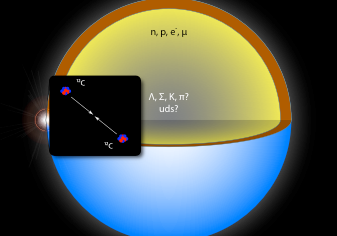
Cutaway schematic of a neutron star. While the core (yellow) contains nucleons and possibly more exotic particles, the crust (brown) contains “normal” nuclei such as 12C. If the crust is heated sufficiently via accretion, the 12C nuclei can “fuse” (inset) and produce a powerful explosion. The properties of the explosion provide information about the physics of the deep crust and core.
Image credit: E. Brown (JINA/MSU).
A Possible Resonance in the Carbon Fusion Cross-Section
Observationally inferred superburst ignition depths are shallower than models predict. A possible resolution to this mystery has been proposed by JINA visitor R. Cooper and JINA members A. Steiner and E. Brown. Cooper et al. showed that all electron capture reactions are thermally stable in accreting neutron star oceans and thus are not a viable “trigger” mechanism. In addition, fusion reactions other than 12C + 12C are infeasible as well. Cooper et al. then examined the 12C + 12C fusion rate. The reaction cross section (a measure of the likelihood that two colliding 12C nuclei will fuse) is experimentally unknown at astrophysically relevant energies, but resonances (strong enhancements in the cross-section at certain specific energies) exist in the 12C + 12C system throughout the entire measured energy range. Thus it is likely, and in fact has been predicted, that a resonance exists near an energy relevant for 12C nuclei in the dense crust of an accreting neutron star. Cooper et al. showed that such a hypothetical resonance would decrease the theoretically predicted superburst ignition depth by up to a factor of 4; in this case, observationally inferred superburst ignition depths would accord with model predictions for a range of plausible neutron star parameters. Determining whether such a strong resonance in fact exists may be possible with proposed underground accelerators, such as at DUSEL. If such a resonance exists, it would also lower the temperature at which 12C ignites in massive post-main-sequence stars. This in turn might have consequences for nucleosynthesis.